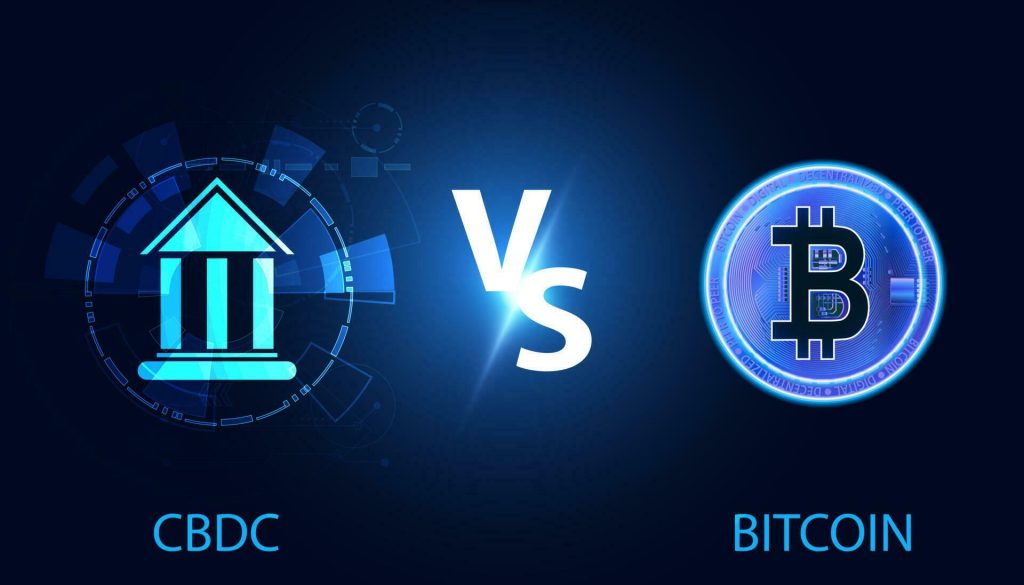The digital money revolution is accelerating. On one side, decentralized cryptocurrencies such as Bitcoin (BTC) and Ethereum (ETH) have built multi-trillion-dollar ecosystems fueled by open networks, innovation, and a distrust of centralized financial systems. On the other side, governments and central banks are rapidly developing Central Bank Digital Currencies (CBDCs)—sovereign-backed digital versions of fiat currencies like the euro, dollar, and yuan.
This raises one of the most pressing questions in financial and technological circles: Will CBDCs compete with or even replace cryptocurrencies as a primary form of digital money? To answer this, we must examine what CBDCs are, how they interact with BTC and ETH use cases, and how regulatory integration may shift the balance of power in the evolving global economy.
What Are CBDCs, and Why Are They Being Developed?
Central Bank Digital Currencies are state-backed digital representations of fiat money, issued directly by central banks. Unlike cryptocurrencies, they are not decentralized, and unlike stablecoins, they carry the full faith and credit of the issuing government.
- Core Objectives of CBDCs
- Financial Inclusion: Enable access to digital payment systems for populations without bank accounts.
- Efficiency in Payments: Lower costs and increase speed in domestic and cross-border transfers.
- Monetary Policy Tools: Give central banks more direct control over money supply and interest rates.
- Reduced Reliance on Private Stablecoins: Governments see CBDCs as a counter to private tokens like USDT or USDC.
- Examples of CBDC Development
- China’s Digital Yuan (e-CNY): Already live in pilot programs across multiple provinces, with millions of users.
- Europe’s Digital Euro: Planned for rollout later this decade, focusing on integration with banking infrastructure.
- U.S. Digital Dollar: Still in research phases, with political debate over privacy and centralization concerns.
- Emerging Markets: Countries like Nigeria (eNaira) and the Bahamas (Sand Dollar) have launched CBDCs to improve financial infrastructure.
CBDCs are, in essence, the government’s answer to crypto, designed to retain sovereignty over money in a digital-first era.
Impact of CBDCs on Bitcoin and Ethereum Use Cases
While CBDCs are often framed as a threat to cryptocurrencies, their influence varies depending on the use case. BTC and ETH, as top cryptocurrencies, serve different roles in the digital economy.
1. Bitcoin: Digital Gold vs. Digital Dollar
- Store of Value: Bitcoin’s primary role is as a hedge against inflation and monetary debasement. CBDCs, being centralized fiat extensions, do not solve inflation risk—if anything, they reinforce reliance on central banks.
- Cross-Border Payments: Bitcoin offers censorship-resistant international transactions, while CBDCs aim for efficiency but remain under geopolitical influence. For example, U.S. sanctions could still block CBDC transfers, whereas BTC offers neutral rails.
- Adoption Threat: CBDCs may reduce Bitcoin’s appeal in payments, but its digital gold narrative is unlikely to be displaced.
2. Ethereum: Programmable Finance vs. State Infrastructure
- DeFi Ecosystem: Ethereum powers decentralized finance, NFTs, DAOs, and tokenization. CBDCs, while programmable, are permissioned systems with limited innovation scope.
- Stablecoins on Ethereum: CBDCs could directly compete with stablecoins like USDC and USDT that dominate ETH-based DeFi. If CBDCs integrate into DeFi, they could disrupt stablecoin usage.
- Smart Contracts: Ethereum’s open innovation cannot be replicated by CBDCs. Governments may use CBDCs as settlement layers, but innovation will likely remain in public blockchains.
3. Shared Challenges and Opportunities
- Competition in Payments: CBDCs may capture mass retail payments, leaving BTC/ETH niches in store-of-value and programmable finance.
- Bridging Potential: If CBDCs can interact with blockchain networks via tokenized versions, BTC and ETH could integrate rather than compete directly.

Regulatory Integration: The Deciding Factor
The most significant competitive pressure may not come from technology but from regulatory integration of CBDCs.
- Government Favoritism
CBDCs will naturally receive regulatory priority. They will be legal tender, integrated into banking, and supported by payment providers. By contrast, BTC and ETH will face continued regulatory scrutiny, particularly regarding AML/KYC obligations. - Stablecoin Regulation
CBDCs pose the greatest threat to private stablecoins, not Bitcoin or Ethereum directly. Governments may argue that stablecoins are redundant or risky once CBDCs exist. Since stablecoins underpin much of DeFi and trading liquidity, this could indirectly affect Ethereum’s dominance. - Surveillance vs. Privacy
- CBDCs raise privacy concerns: governments could theoretically track every transaction.
- Cryptocurrencies maintain pseudonymity, appealing to users who value financial freedom.
- Regulatory decisions on privacy will shape adoption: if CBDCs are seen as invasive, BTC and ETH may strengthen as alternatives.
- Geopolitical Impacts
- CBDCs could shift global financial power, especially if the digital yuan gains traction in cross-border trade.
- Bitcoin and Ethereum, as neutral global assets, may remain attractive for those seeking to hedge against geopolitical risks.
Will CBDCs Complement or Replace Cryptos?
The future likely involves coexistence, not replacement.
- CBDCs: Designed for mainstream retail payments, government-backed transactions, and monetary policy control.
- Bitcoin: Retains its role as digital gold and a hedge against monetary manipulation.
- Ethereum: Powers decentralized applications, tokenization, and alternative financial infrastructure that CBDCs cannot replicate.
In fact, CBDCs may expand crypto adoption indirectly:
- They will familiarize populations with digital wallets, tokenized money, and blockchain-like systems.
- Once users understand programmable money, many may transition to more open systems like Ethereum.
- CBDCs could even integrate with blockchain rails for efficiency, creating hybrid ecosystems.
Challenges Facing CBDCs That Benefit Cryptos
- Trust Issues: Citizens may resist CBDCs due to concerns about surveillance and financial control.
- Innovation Limits: Governments cannot match the rapid innovation pace of open-source communities.
- Global Interoperability: CBDCs risk becoming fragmented, while BTC and ETH already function globally.
- Inflation Risks: CBDCs will still be fiat currencies subject to central bank policies, while BTC remains fixed in supply.
Conclusion: Competing or Coexisting?
CBDCs will undoubtedly change the landscape of digital finance, but they are unlikely to eliminate the roles of Bitcoin and Ethereum.
- Bitcoin remains a decentralized hedge against inflation and censorship, untouched by central bank policy.
- Ethereum thrives as the innovation hub for decentralized finance and digital ecosystems.
- CBDCs may dominate payments and regulatory integration, but their centralized nature limits them from fully replacing crypto.
Instead of a zero-sum battle, the outcome may be a layered ecosystem:
- CBDCs for state-controlled payments.
- Stablecoins for crypto-trading liquidity.
- Bitcoin as digital gold.
- Ethereum as programmable infrastructure.
The competitive threat is real, but cryptocurrencies’ resilience lies in their decentralization, innovation, and global neutrality—qualities no CBDC can replicate.































